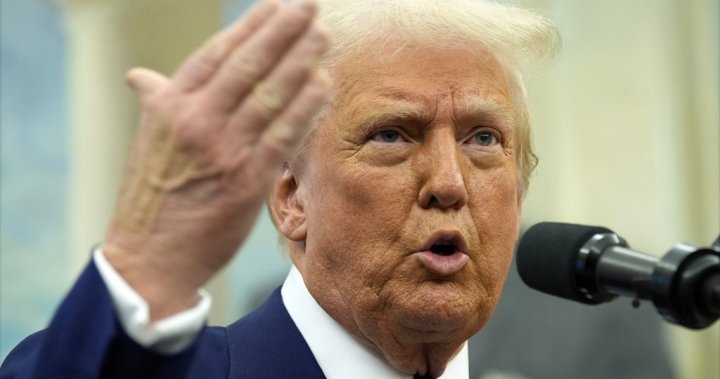Canada
Trump orders tariffs on digital service tax countries, including Canada

U.S. Imposes Tariffs on Countries Taxing American Tech Giants: A Move to Protect Economic Interests
Introduction: Trump’s Memorandum on Digital Service Taxes
In a bold move to safeguard American economic interests, former U.S. President Donald Trump signed a memorandum directing his administration to impose tariffs on countries that levy digital service taxes (DSTs) on U.S. technology companies. This decision came as a response to what the White House described as unfair taxation practices by foreign governments targeting American firms. A senior official emphasized that President Trump would not stand idly by while foreign nations benefited from taxes imposed on U.S. companies, stating, “President Trump will not allow foreign governments to appropriate America’s tax base for their own benefit.” This move marked a significant escalation in trade tensions over digital taxation, a issue that has been simmering for years.
The Digital Tax Dispute: A Global Trade Challenge
The digital service taxes, implemented by several countries including Canada, France, Italy, Spain, Turkey, India, Austria, and the United Kingdom, target revenues earned by U.S. tech giants such as Google, Facebook, Apple, and Amazon from digital services sold within their borders. These taxes have been a contentious issue in international trade, with the U.S. arguing that they unfairly discriminate against American companies. During Trump’s first term, the U.S. Trade Representative’s (USTR) office launched investigations into these taxes, concluding that they indeed discriminated against U.S. firms. The USTR readied retaliatory tariffs, setting the stage for a prolonged trade dispute.
Trump’s Tariff Threat: A Strategy to Level the Playing Field
President Trump’s memorandum directed the USTR to revive these investigations and consider imposing tariffs on goods from countries that continue to enforce DSTs. The move was framed as a way to combat what the administration viewed as non-reciprocal and unfair taxation practices. The White House argued that these taxes cost U.S. companies over $2 billion annually, with Canada and France alone collecting more than $500 million each year. By imposing reciprocal tariffs, the administration aimed to restore fairness to the international trade system and prevent American businesses from being unfairly targeted. As stated in a White House fact sheet, “Only America should be allowed to tax American firms.”
The Biden Administration’s Approach: Negotiations and Suspended Tariffs
When President Joe Biden took office, his trade chief, Katherine Tai, continued the probes into DSTs but adopted a different strategy. In 2021, the USTR announced 25% tariffs on over $2 billion worth of imports from six countries, including the UK, Italy, and Spain. However, these tariffs were immediately suspended to allow negotiations on a global tax deal to proceed. The negotiations led to a 15% global corporate minimum tax agreement, which was hailed as a breakthrough. However, the deal failed to gain ratification from the U.S. Congress, and talks on a second component, aimed at creating an alternative to DSTs, stalled without a consensus.
Trump’s Return to Protectionism: Reviving Retaliatory Measures
President Trump’s return to office in 2023 saw a shift back to a more confrontational approach. On his first day in office, Trump effectively withdrew the U.S. from the global tax arrangement, declaring that the 15% global minimum tax had “no force or effect in the United States.” He directed the U.S. Treasury to prepare options for “protective measures,” signaling a return to the retaliatory tariffs that had been suspended during the Biden administration. The USTR’s investigative powers were renewed, and the administration indicated that tariffs could be reimposed on goods from countries continuing to enforce DSTs. This move was seen as a clear warning to foreign governments to rethink their taxation policies.
The Future of Digital Taxation: Uncertainty and Trade Tensions
The U.S. decision to revive tariffs on countries enforcing DSTs has introduced new uncertainty into the global trade landscape. While the Biden administration had pursued a negotiated solution, the Trump administration’s return to a more protectionist approach has reignited tensions. The U.S. has long maintained that DSTs unfairly target American tech companies, and the imposition of retaliatory tariffs is intended to offset the revenue lost to these taxes. However, the broader implications of this move remain unclear. As trade relations continue to evolve, one thing is certain: the dispute over digital taxation will remain a contentious issue in international trade, with significant implications for global economic cooperation and competition.











